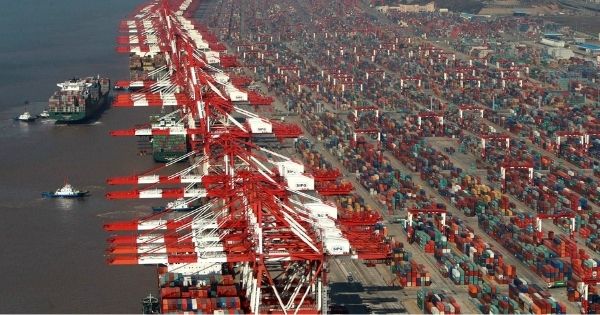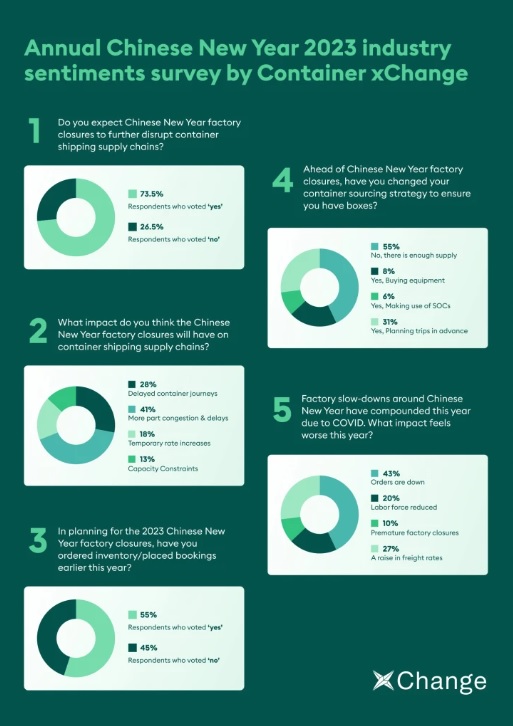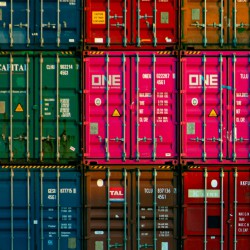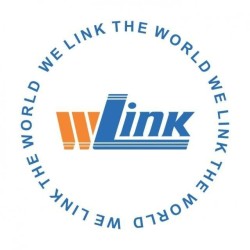2023 Lunar New Year in China, the worry of shipping disruption more than 2022
According to a survey by Container Xchange, 73% of respondents said that the Chinese Lunar New Year will disrupt shipping compared to 66% in 2022. This contrasts with industry reports with a less impact.

Port of Shanghai, China (Photo: Imgur)
The Lunar New Year, which takes place in China every year, is always a time to reduce the efficiency of logistics services between China and the rest of the world. However, 2023 will be affected more than usual.
The majority of freight forwarders and supply chain professionals this year are predicting more disruption than 2022 due to the coronavirus outbreak in China and the New Year holiday factory closures, according to Container Xchange.

The 2023 Lunar New Year in China causes more supply chain disruptions than usual (Source: Container Xchange)
"We are looking at three different Chinese New Years in 2020, 2021 and 2022. It’s not what we’ve been accustomed to in the prior years when there was demand leading up to the Chinese New Year," said Cathy Morrow Roberson, founder and president of Logistics Trends & Insights LLC, during a webinar. "There is a lot of inventory with retailers and manufacturers. Inflation and fear of recession continue to impact demand. And therefore, the spot rates have started to fall off the cliff." She added.
The Lunar New Year in China is a period of mass migration of Chinese workers. Production spiked in the days leading up to the festival as factories struggled to keep up with rapidly increasing demand. But, during the festival, production activities slow down or stop altogether across the country.
Container Xchange's annual New Year survey, received 2,300 responses.
This year, 73% of respondents said the Chinese Lunar New Year will disrupt shipping compared to 66% in 2022. This contrasts with industry reports of less impact. Of those 73%, 65% are freight forwarders and the rest are general supply chain professionals.
The Lunar New Year is earlier than usual, an expert said - there is usually a commodity rush in January and February. That will impact China's supply chain from January 15 to May 6. 2 year 2023.
Most respondents said the increase in port congestion and container shipping delays was the strongest impact after China reopened. Last year, most industry experts were concerned about capacity issues and higher rates after the Lunar New Year.
"I think an ‘increase in port congestions and delays’ and ‘delayed container journeys’ will be the possible result as it makes sense to me that once they all ship out again, that means more ships leaving closer to one another for the same destinations, which may cause backups for a short time," said one survey respondent.
"There are new complexities ahead coupled with the Chinese New Year where at one end we see China coping with the Covid infections, and on the other end we see continued dip in demand," commented Roeloffs.
The biggest concern, Roeloffs said, is the reduction in output and port capacity due to the coronavirus outbreak in China. In addition, freight rates are low, capacity management remains a top priority for carriers, and many blank sailings are carried.
Sea freight rates on the transpacific route to the US West Coast have fallen below 2019 levels over the past few weeks. Rates to the US East Coast are 83% lower than they were a year ago. There are also reports of many blanked sailings from Asia to the Mediterranean.
"In the coming weeks, we do foresee prolonged factory closures and bearish market conditions," Roeloffs said.
Regarding plans for the Lunar New Year, 55% of respondents have ordered a reserve or made a reservation before festival. Last year that number was 59%, down 4%, Container Xchange reported. In addition, while 65% of international freight forwarders said they forecast the impact of the Lunar New Year holiday on the supply chain, only 47% had a plan in place to deal with it.
Read more:
- Spot container freight rates stable but blanked sailings increased before Lunar New Year
- Inflation and recession top concerns for supply chains in 2023
Source: Phaata.com (According to Container Xchange, EPSNews)
Phaata - Vietnam's First Global Logistics Marketplace
► Find Better Freight Rates & Logistics Services













.png)









.jpg)


